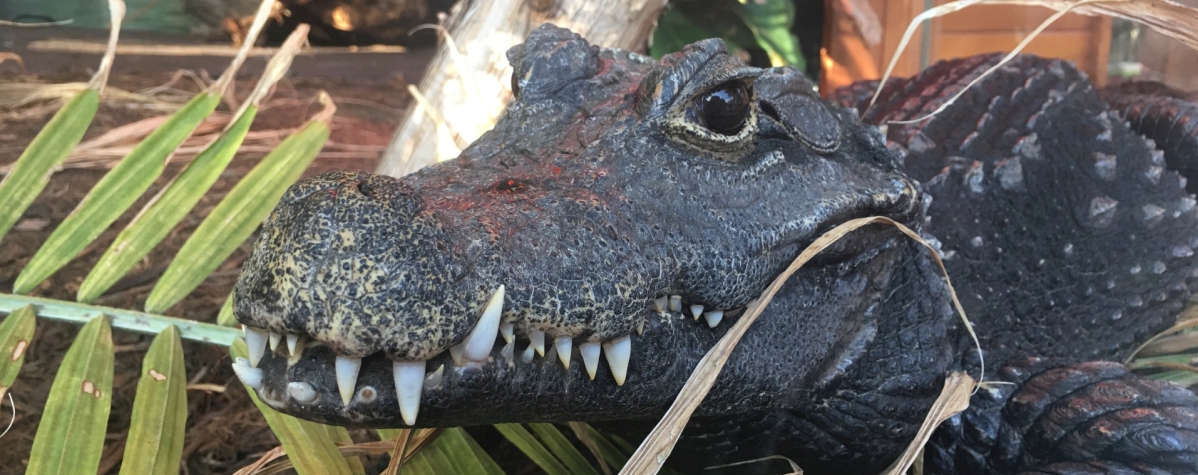Wild Turkey
Scientific Classification 
| Species | Meleagris gallopavo |
| Kingdom | Animalia |
| Phylum | Chordata |
| Class | Aves |
| Order | Galliformes |
| Family | Phasianidae |
| IUCN Status | Least Concern |
Appearance and lifespan
Adult Wild Turkeys have long reddish-yellow to greyish- green legs and a black body. Males have a large, featherless, reddish head and a red throat, and red wattles on the throat and neck. The head has fleshy growths called caruncles. Each foot has three toes, and males have a spur behind each of their lower legs. Turkeys have a long, dark, fan-shaped tail and glossy bronze wings. The male is much larger than the female, and his feathers have areas of red, purple, green, copper, bronze, and gold. Female feathers are duller, in shades of brown and grey. The primary wing feathers on both males and females have white bars. Males typically have a “beard” which is a tuft of coarse hair growing from the centre of the breast. Beards average 22 cm (9 in) in length. About 10 to 20 percent of females have a beard, usually shorter and thinner than the males.
The adult male normally weighs from 4.4 to 10.8 kg (11 to 24 lbs) and measures 100 to 125 cm (39 to 49 in). The adult female is much smaller at 2.9 to 5.4 kg (6.6 to 12 lbs) and is 76 to 95 cm (30 to 37 in) long. The wingspan ranges from 1.2 to 1.4 m (49 to 57 in).
The record-sized adult male Wild Turkey, per the National Wild Turkey Federation, was 17.2 kg (38 lb). The lifespan of a Wild Turkey is usually 3 to 4 years in the wild but can be up to 13 years in captivity.
Behavior and reproduction
Wild Turkeys are very agile fliers. Turkeys are very cautious birds and will fly or run at the first sign of danger. Turkeys have many vocalizations and can be heard up to a mile away. In early spring, male turkeys gobble to announce their presence to females and competing males. Hens “yelp” to let males know their location.
Males mate with as many hens as they can. Male Wild Turkeys display for females by puffing out their feathers, spreading out their tails and dragging their wings. When males are excited, a fleshy flap on their bill, wattles, and the bare skin of the head and neck all become engorged with blood, almost covering the eyes and bill. This behavior is known as strutting. Their heads and necks are coloured brilliantly with red, blue and white. The colour can change with the turkey’s mood, with a solid white head and neck being the most excited. Courtship begins during the months of March and April, which is when turkeys are still flocked together in winter areas.
When mating is finished, females search for nest sites. Nests are shallow dirt depressions engulfed with woody vegetation. Hens lay a clutch of 10 to 14 eggs, usually one per day. The eggs are incubated for at least 28 days. The chicks leave the nest in about 12 to 24 hours.
Ecology and conservation
The ideal habitat for Wild Turkeys is an open woodland or savanna, where they can fly beneath the canopy top and find perches. Wild Turkeys like open areas for feeding and mating. They use forested areas as cover from predators and for roosting in trees at night. A varied habitat of both open and covered area is essential for wild turkey survival.
Wild Turkeys are omnivorous, foraging on the ground or climbing shrubs and small trees to feed. They prefer eating acorns and nuts, but will also eat various seeds, berries, roots and insects. Turkeys also occasionally eat amphibians and small reptiles such as newts and snakes. Turkeys are also known to eat a wide variety of grasses.
Food at the Zoo
At the Zoo, the Wild Turkeys eat scratch grain, turkey feed, lettuce, mixed veggies, and apples along with insects and plants they find around their exhibit.
Threats
At one time the number of Wild Turkeys was low; they were almost extirpated from Canada and only survived in small areas of the US. This was due to hunting and habitat loss. Protection efforts were made and were successful. The Wild Turkey population is stable and estimated to be around 7 million individuals. Humans are now the leading predator of adult turkeys.
Did you know?
- Turkeys have 5000 to 6000 feathers.
- Turkeys can run at speeds up to 40kph (25 mph), and they can fly up to 88kpm (55 mph).
- Wild turkeys have excellent vision during the day but don’t see as well at night.


